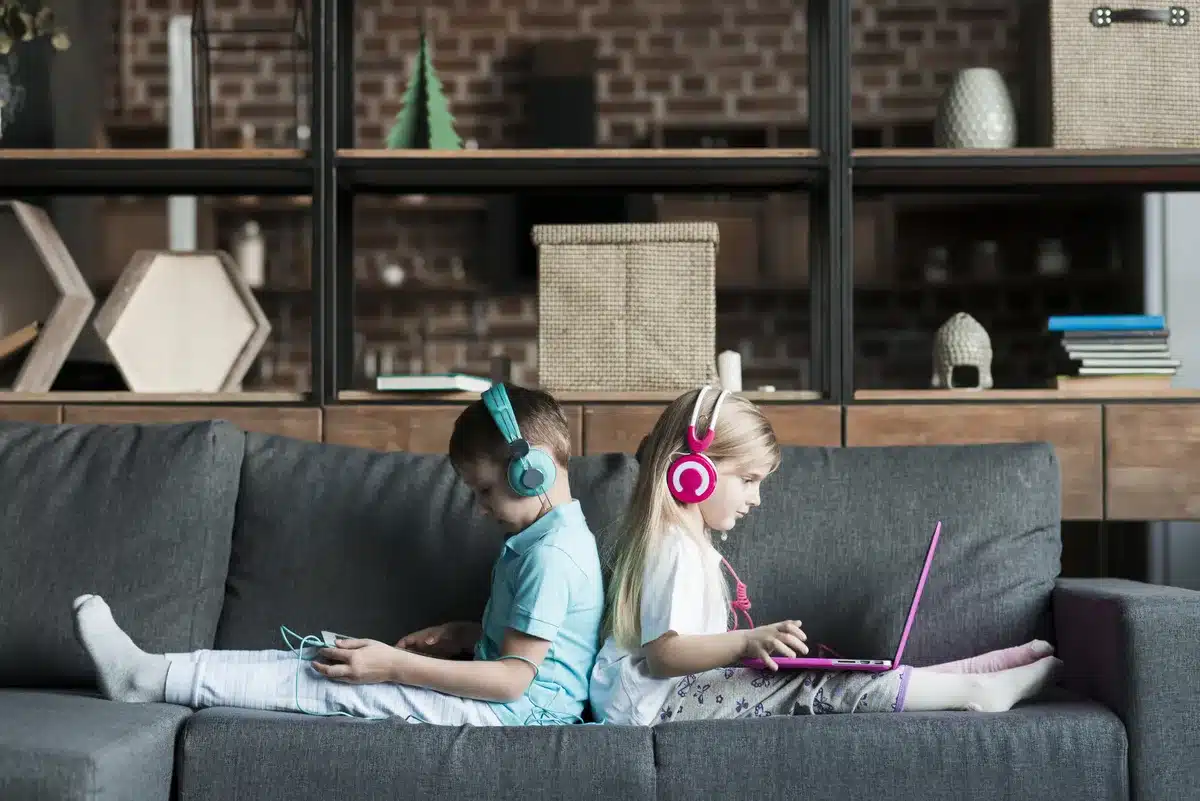The increasing prevalence of screens, including social media platforms, in modern life has led to a pressing question: should parents limit screen time? This question has become particularly significant given the potential adverse effects of screen time in excess, including social media engagement, on children’s physical and psychological health. The American Academy of Pediatrics (AAP) provides specific recommendations on screen time exposure according to age, offering parents and caregivers a guide on how to effectively manage the use of screens, including social media, in children’s lives to ensure their healthy development.
Why Should Parents Limit Screen Time?

Screen time is more than just a thief of hours that could be spent running, playing, or learning. It’s a tricky problem that can affect every part of a child’s life. Sure, digital technology offers lots of knowledge and chances for creativity, but it’s also easy to get lost in it. It’s full of things that keep kids sitting still, draw them in and won’t let go, and make it hard to tell where the online world stops and the real world starts.
But don’t worry, there’s good news too. There are ways to reduce children’s screen time and restore a healthy balance. You can make parts of your house screen-free, or help your kids find other ways to have fun. The goal is to take control back from the screens and help children grow in all areas of life.
The challenge now lies in understanding the depth of screen time’s impact, identifying the risks associated with screens as default babysitters, and actively seeking, implementing, and normalizing these important countermeasures.
Potential consequences of too much screen time
Excessive screen time can lead to a number of adverse effects on children’s wellbeing.
Here are a few potential consequences that parents should be aware of:
- Exposure to the blue light emitted by screens can disrupt children’s sleep patterns.
- The amount of screen time a child has can inversely affect their physical activity levels, contributing to a sedentary lifestyle.
- Pediatricians warn of potential developmental delays in children who spend excessive time in front of screens.
- Increased screen time can lead to increased instances of tantrums as children may struggle with self-regulation when it’s time to turn off devices.
- The continuous scrolling on an iPad or other devices can become an addictive behavior, affecting children’s ability to focus on non-digital tasks.
Promoting healthy development and well-being
Reducing the time spend in front of the screen can have numerous benefits for children’s development and overall well-being.
Here’s how parents can promote healthy development:
- Encouraging social skills: Less time in front of the screen means more time for face-to-face interactions, which are essential for developing social skills.
- Enhancing family time: By setting aside screens during specific times, families can engage more deeply with each other, strengthening bonds and communication.
- Offering opportunities for physical activity: Less screen time allows for more active play, contributing to physical health and coordination.
Parents, caregivers, and educators should work together to limit and monitor children’s screen time, as well as promote alternative, developmentally beneficial activities.
Should Parents Limit Screen Time? Pros and Cons of Screen
Navigating the digital age as a parent can be quite challenging, especially when it comes to screen time. How much is too much? What is the impact of screens on our children’s health and development? These questions may lead many to ask, “Should parents limit screen time?” This topic is often complex, with various aspects to consider. To help illuminate the subject, we’ll be taking a concise look at the pros and cons of setting limits on screen time.
Pros of Limiting Screen Time
The benefits of reducing a child’s time spent in front of a screen are significant and diverse. From physical health to cognitive development, limiting the time spent in front of a screen can promote a more balanced lifestyle for kids. Let’s discover some advantages associated with less screen exposure.
Improved physical and mental health

A major benefit of limiting screen time is the enhancement of both physical and mental health. As children replace time spent in front of screens with physical activities, the risk of obesity significantly decreases. The promotion of regular mealtimes without the distraction of screens also encourages healthier eating habits and can contribute to improved overall wellness.
Enhanced social interaction and communication skills
By reducing screen time, children are provided with more opportunities to interact with family members and peers. The digital world often lacks the depth and complexity of real-life social interactions, which are crucial for developing strong communication skills. Spending less time with screens and more time engaging in face-to-face conversations fosters empathy, emotional intelligence, and a better understanding of social norms.
Increased creativity and imagination
Another significant advantage is the potential for increased creativity and imagination. Young children, as well as adolescents, are inherently imaginative, and they often express their creativity through play. When children swap screen time with activities such as drawing, painting, or playing board games, they use and develop their ability to generate new ideas, think critically, and problem-solve in unique ways. These offline activities stimulate their minds and encourage them to explore different perspectives, fostering a deeper sense of curiosity and intellectual growth. By engaging in hands-on creative endeavors, children learn to visualize concepts, experiment with various materials, and translate their thoughts into tangible creations. This not only enhances their artistic skills but also hones their cognitive flexibility, allowing them to adapt to different challenges and think outside the box.
Cons of Limiting Screen Time
While the benefits of limiting the use of screens are clear, it’s also important to recognize the potential challenges involved in implementing these changes.
You’ll need more time to balance screen time with other activities
Balancing your kid’s screen time with other activities can require a significant time investment, particularly during weekdays when children might rely on screens during their free time. Parents need to plan and engage in high-quality activities or educational programs to occupy the time previously filled with screens, which can be particularly demanding in terms of effort and resources.
Addressing potential resistance or pushback from children
When limiting screen time, parents should also prepare for potential resistance or pushback from children, who may not initially understand or appreciate the change. This resistance can take the form of tantrums or emotional outbursts, particularly if screens have become a major part of their daily routine. It’s crucial for parents to be patient, understanding, and consistent in enforcing the new screen time limits despite these initial challenges.
How to Limit Screen Time in 3 easy steps

The prevalence of digital media in our society has led to a noticeable trend among parents – the use of screens as an inexpensive and readily available alternative to traditional babysitting. With just a click, devices such as smartphones, tablets, and televisions can easily captivate children, providing parents with a temporary reprieve. However, this apparent easy fix has a trap. Screens, despite their potential as learning tools, cannot replace human interactions necessary for child development. The overuse of screen time might serve as a short-term solution, but it poses potential long-term repercussions on a child‘s wellbeing. Thus, while screens undeniably have a place in our children’s lives, their usage needs to be balanced and thoughtful, rather than serving as an automatic go-to for child supervision.
Establish Screen Time Guidelines
When attempting to reduce your child’s screen time, the first step is to establish age-appropriate guidelines. The American Academy of Pediatrics recommends different screen time limits for different ages. For example, for children under 18 months, screen time should be limited to video chatting with family and friends. For older children and teenagers, the guidelines are a bit more flexible, but the emphasis remains on quality over quantity.
👉 Are you looking to regain control over your child’s screen time and establish proper limits for TV watching? Read more in our article on ‘Effective Screen Time Management for Kids‘ to discover valuable strategies.
Set clear expectations and rules
Once you’ve established your screen time guidelines, it’s essential to set clear expectations and rules regarding media use. For instance, you might set rules about what times of day screens can be used, what types of media are allowed, and how many hours of screen time are acceptable per day. It’s essential to discuss these rules with your children so they understand the reasons behind them and the benefits of limiting screen time.
Encourage Alternative Activities

Another important component of managing your child’s screen time is to encourage alternative activities. Here are a few ideas:
- Promoting physical exercise and outdoor play: Physical activity is vital for your child’s health and development. Encourage them to play outside, participate in sports, or take a walk with you.
- Stimulating creativity through art, reading, and hobbies: Encourage your child to engage in creative activities such as drawing, painting, playing an instrument, or reading. These activities not only stimulate creativity but also promote focus and cognitive development.
- Encouraging social interactions and family bonding time: Spending quality time as a family, such as playing board games, cooking together, or having a family movie night, can help strengthen the parent-child bond and provide an alternative to screens.
Managing Screen Time Usage
Effectively managing your child’s screen time can feel like a daunting task, particularly in our increasingly digital world. However, by implementing some thoughtful strategies, you can help ensure that your child’s screen time is both limited and beneficial. Here are a few methods you can employ:
- Implementing parental controls and monitoring tools on cell phones: These features can help you regulate the amount of time your child spends on their phone and control the content they can access. They also allow you to block certain apps or set time limits for usage.
- Designating screen-free zones and times: Establish certain areas in your home, like the dining room or bedrooms, as screen-free zones. Additionally, designate screen-free times such as during meals or an hour before bedtime.
- Being a role model and practicing mindful technology use: Children often imitate the behavior they see, so it’s important for parents to set a good example. Be mindful of your own screen use and demonstrate balanced, responsible behaviors when it comes to technology. This can include setting aside your own devices during family time or refraining from using screens in designated screen-free zones.
👉 Curious about the link between your child’s restlessness and the negative effects of video games? Explore our article to uncover insights and solutions. Take the first step towards a more balanced and peaceful environment for your child!
The journey to creating a healthy digital balance for children is one of continuous learning and adaptation. While it may initially seem challenging, it is important to remember that the goal is to cultivate a healthy relationship with technology, not to eliminate it entirely.
Limiting screen time for young children has long-term benefits that extend beyond the immediate reduction of potential harmful effects. It fosters a broader perspective of the world beyond screens, encourages real-life interactions, promotes physical health, and stimulates the creative mind. Furthermore, it empowers children to develop essential life skills, such as self-regulation, problem-solving, and communication. So, the answer to this question, “Should parents limit screen time?” is yes. By setting reasonable limits and offering alternative activities, parents can guide their children toward a balanced and wholesome upbringing, ensuring that the dazzling allure of screens doesn’t overshadow the multifaceted richness of the world around them.
As parents, you are in a unique position to guide and influence your child’s media use. Our experts created an event “Why Screens Harm Your Child” where you will learn how to implement appropriate guidelines, setting clear expectations, encouraging alternative activities, so you can significantly influence your child’s digital habits. These strategies will not only help manage your child’s screen time but also equip them with the tools they need to navigate the digital world responsibly.
Seeking additional parenting guidance? Engage with Sophie, our clever AI assistant, prepared to offer invaluable insights and solutions to support you on your parenting journey.
References
Adachi-Mejia, A., Longacre, M., Gibson, J., Beach, M., Titus-Ernstoff, L., & Dalton, M. (2006). Children with a TV in their bedroom at higher risk for being overweight. International Journal Of Obesity, 31(4), 644-651. http://doi.org/10.1038/sj.ijo.0803455
Anderson, D., & Pempek, T. (2005). Television and Very Young Children. American Behavioral Scientist,48(5),505-522. http://doi.org/10.1177/0002764204271506
Carson, V., Lee, E. Y., Hesketh, K. D., Hunter, S., Kuzik, N., Predy, M., Rhodes, R. E., Rinaldi, C. M., Spence, J. C., & Hinkley, T. (2019). Physical activity and sedentary behavior across three time-points and associations with social skills in early childhood. BMC public health, 19(1), 27. https://doi.org/10.1186/s12889-018-6381-x
Chen, J.-Y., Strodl, E., Huang, L.-H., Chen, Y.-J., Yang, G.-Y., & Chen, W.-Q. (2020). Early electronic screen exposure and autistic-like behaviors among preschoolers: The mediating role of caregiver-child interaction, sleep duration and outdoor activities. Children, 7(11), 200. https://doi.org/10.3390/children7110200
Hawi, N. S., & Rupert, M. S. (2015). Impact of e-discipline on children’s Screen Time. Cyberpsychology, Behavior, and Social Networking, 18(6), 337–342. https://doi.org/10.1089/cyber.2014.0608
Kerai, S., Almas, A., Guhn, M., Forer, B., & Oberle, E. (2022). Screen time and developmental health: results from an early childhood study in Canada. BMC public health, 22(1), 310. https://doi.org/10.1186/s12889-022-12701-3
Khouja, J. N., Munafò, M. R., Tilling, K., Wiles, N. J., Joison, C., Etchells, P. J., John, A., Hayes, F. M., Gage, S. H., & Cornish, R. P.(2019). Is screen time associated with anxiety or depression in young people? Results from a UK birth cohort. BMC Public Health 19, 82. https://doi.org/10.1186/s12889-018-6321-9
Schoeppe, S., Rebar, A. L., Short, C. E., Alley, S., Van Lippevelde, w., & Vandelanotte, C. (2016). How is adults’ screen time behaviour influencing their views on screen time restrictions for children? A cross-sectional study. BMC Public Health 16, 201. https://doi.org/10.1186/s12889-016-2789-3
Yousuf, M. S., Harvey, H. L., Parahoo, S. K., Ziadeh, B. S., Kilani, M., & Al-Kamil, E. (2021). The effects of pediatric primary prevention programs on screen-time and reading habits of children in Jordan. International Journal of Child Care and Education Policy, 15. https://doi.org/10.1186/s40723-021-00092-8









